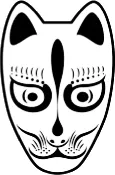The Tale of the Mouse
The Tale of the Mouse (Nezumi no sōshi) belongs to a subgenre that modern scholars call “interspecies” (irui-mono) tales, in which non-humans act and speak like humans and interact with human beings in this world. Contemporary readers would have understood the world to be divided into the Six Realms of heaven, ashura, humans, animals, hungry ghosts, and hell. The mice in this tale seek to escape from the realm of animals, and for a brief time they are able to transgress the boundary between the human and bestial realms.
Major highlights of the narrative are the wedding preparations and the wedding reception, which are described and painted in loving detail. The picture scroll consists of an erudite, humorous narrative that alternates with lavish illustrations of frolicking mice. Bits of text in the paintings (gachūshi) take the form of transcribed speech and labels identifying the characters or places. The contrast between the more serious tone of the main text and the irreverent chatter of the servants in the gachūshi is a part of the otogizōshi’s charm. The servant-mice in the painted images speak in an eastern dialect that is exaggerated for comic effect. As they work, they sing songs, at least one of which is based on a song that would have been well known in the sixteenth century. Most notably, the waka poems that the protagonist Gonnokami composes on the belongings that his human wife leaves behind overflow with allusions to famous poems from The Tale of Genji (early eleventh century), all of which were well known and would likely have been recognizable to an educated reader in the sixteenth and seventeenth centuries. Other sections of the story are also potentially didactic (probably intended to educate young readers): the discussion of the history of noh, the demonstration of different methods of divination, and even the comical conversation about the Five Precepts of Buddhism.
The lineage of The Tale of the Mouse to which the text translated here belongs includes the largest number of surviving manuscripts, and their words and images are nearly identical. It is widely believed that these illustrated manuscripts were produced by a picture-scroll studio in the late Muromachi (1337–1573) or early Edo (1600–1867) period. Some of the mice in the illustrations are named after recognizable public figures, including noh actors and the tea master Sen no Rikyū (1522–1591), which has helped scholars to date this group of scrolls.
Once upon a time, a venerable old mouse named Gonnokami lived near the Horikawa Mansion on Fourth Avenue in the capital. Perhaps due to this Latter Age of the Buddhist Law, when things have deteriorated, the mouse, in the tedium of a rainy day, summoned his retainer, Sakonnojō the Hole-Digger, Captain of the Left Inner Guards, and said, “What karma we must carry from our previous lives, Sakonnojō, that we were born not only as beasts, but as such small beasts! How vexing! But I have an idea. What if I were to wed a human so that my descendants would be liberated from this realm of beasts?”
“What a splendid idea!” Sakonnojō replied. “Please decide soon, and exchange vows with whomever you like. If you’ll excuse my frankness, your appearance is no different from that of the Shining Genji of old when he lingered by Yūgao’s lodging at dusk, or Commander of the Right Gate Guards Kashiwagi when he stood in the shadow of a cherry tree and set his sight on the cat’s leash. You would not even pale in comparison with the Fifth Rank Middle Captain Ariwara no Narihira when he gazed upon the cherry blossoms scattering like snow at dawn on the Katano Plain. Why should a man as handsome as you settle for any ordinary woman? The daughter of the Yanagiya—a girl of seventeen or eighteen, I think—lives on Oil Lane around Fifth Avenue, not too far from here. For years, she has been on my mind, and I have peeked at her, through the hinges of folding screens, beneath verandas, through the holes that visiting crickets have chewed in the walls, through knotholes, and all sorts of nooks and crannies, and there is no maiden more beautiful than she. Her beauty is like a willow swaying in the breeze; like flowering crab apples in the garden smiling in the spring rain, announcing from the shade of the dormant cherry trees the coming of spring; or like the hazy moon emerging from the mist. She is beyond compare, bringing to mind the women of old of whom the poets wrote such things. I think that any woman other than this would be a poor match for your noble heart. However, it may be difficult to fulfill your wishes in the ordinary ways. Fr...



